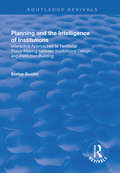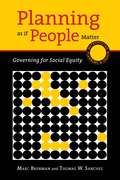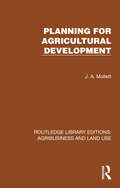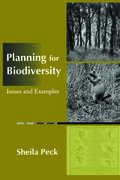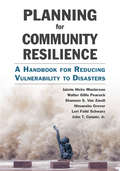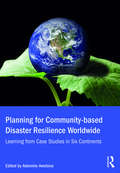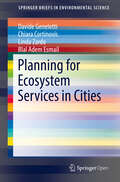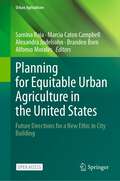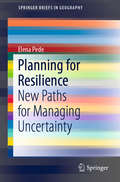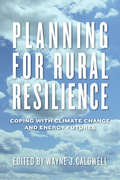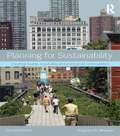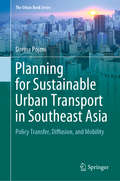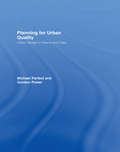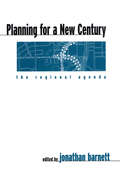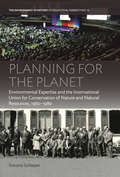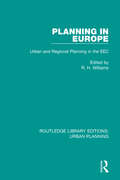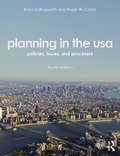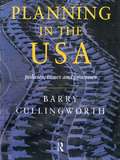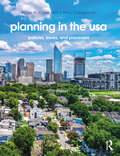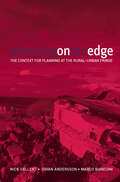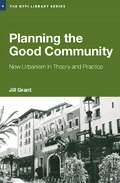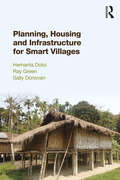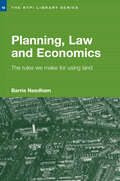- Table View
- List View
Planning and the Intelligence of Institutions: Interactive Approaches to Territorial Policy-Making Between Institutional Design and Institution-Building (Routledge Revivals)
by Enrico GualiniThis title was first published in 2001. The hierarchical approach of regional planning institutions is facing crisis. In an era of globalization, the conditions of urban growth dynamics is dependent on innovation, entrepreneurial and economic structures and socio-political and institutional forces. As a result, the notion of 'region' has become more about social interaction than geographical location. This volume examines how institutions must adapt and modify their roles to suit this changing pattern of development, by implementing more consensus-based approaches. Using in-depth analysis of an innovative state-sponsored approach to growth management planning in the USA, it assesses the effectiveness and success of putting into place more flexible, concerted and negotiated approaches to issues such as inter-institutional relations and inter-governmental co-ordination. In what will be an essential contribution to the debate surrounding the future of regional planning and the role of institutions, the volume highlights the limits and opportunities of these new policy approaches and will be a key resource for planners, policy makers and researchers alike.
Planning as if People Matter: Governing for Social Equity
by Thomas W. Sanchez Marc BrenmanAmerican communities are changing fast: ethnic minority populations are growing, home ownership is falling, the number of people per household is going up, and salaries are going down. According to Marc Brenman and Thomas W. Sanchez, the planning field is largely unprepared for these fundamental shifts. If planners are going to adequately serve residents of diverse ages, races, and income levels, they need to address basic issues of equity. Planning as if People Matter offers practical solutions to make our communities more livable and more equitable for all residents. While there are many books on environmental justice, relatively few go beyond theory to give real-world examples of how better planning can level inequities. In contrast, Planning as if People Matter is written expressly for planning practitioners, public administrators, policy-makers, activists, and students who must directly confront these challenges. It provides new insights about familiar topics such as stakeholder participation and civil rights. And it addresses emerging issues, including disaster response, new technologies, and equity metrics. Far from an academic treatment, Planning as if People Matter is rooted in hard data, on-the-ground experience, and current policy analysis. In this tumultuous period of economic change, there has never been a better time to reform the planning process. Brenman and Sanchez point the way toward a more just social landscape.
Planning for Agricultural Development (Routledge Library Editions: Agribusiness and Land Use #18)
by J. A. MollettOriginally published in 1984, this text was written as a guide to agricultural policy makers, planners and project managers in developing countries, particularly for those in the areas of programme formulation and implementation. Elements from successful agricultural and rural development plans have been selected. The work discusses the link between agricultural and overall planning, the various aspects of agricultural planning (including the usual components and deficiencies of plans, time horizons and scope of plans, and regional planning), and it concludes with brief look at the preparation of a plan and objectives for agricultural development.
Planning for Biodiversity: Issues and Examples
by Sheila PeckA significant consequence of the development of natural landscapes is habitat loss and fragmentation that results in widespread loss of biological diversity. While scientists have made great strides in determining principles and concepts fundamental to preserving biodiversity, their work will have little impact unless it is understood and implemented by those who are making on-the-ground decisions about land use.Planning for Biodiversity is an accessible introduction to ecological concepts for planning professionals and students. Sheila Peck explains why planners should be concerned with habitat preservation and presents practical approaches to incorporating conservation principles into planning efforts. The book introduces a clear framework for understanding biodiversity; explains concepts related to ecosystem structure and function; discusses the effects of size and connectivity on habitat quality and species movement; suggests conservation priorities at different scales; presents elements of reserve design; examines types and sources of information; and considers the causes of uncertainty in biodiversity planning and the need for monitoring and adaptive management.In each chapter, Peck presents case studies, including the Beaverhead/Deerlodge National Forest, Montana; Pinhook Swamp Linkage, northeastern Florida; National Gap Analysis Program; CALFED Bay-Delta Program, California; and numerous others, each of which explore the practical implications of the concepts examined. Planning for Biodiversity synthesizes and explains important ecological concepts and is the first guide for planners that clearly details how to incorporate conservation plans into their work. Planners, landscape architects and designers, planning and design students, developers, local officials, and anyone interested in designing and developing more ecologically sound land-use projects will find the book an invaluable resource.
Planning for Community Resilience: A Handbook for Reducing Vulnerability to Disasters
by Himanshu Grover John T. Cooper Lori Feild Schwarz Jaimie Hicks Masterson Walter Gillis Peacock Shannon S. ZandtHow can we plan and design stronger communities? From New Orleans to Galveston to the Jersey Shore, communities struck by natural disasters struggle to recover long after the first responders have left. Globally, the average annual number of natural disasters has more than doubled since 1980. These catastrophes are increasing in number as well as in magnitude, causing greater damage as we experience rising sea levels and other effects of climate change. Communities can reduce their vulnerability to disaster by becoming more resilient--to not only bounce back more readily from disasters but to grow stronger, more socially cohesive, and more environmentally responsible. To be truly resilient, disaster preparation and response must consider all populations in the community. By bringing together natural hazards planning and community planning to consider vulnerabilities, more resilient and equitable communities are achievable. In Planning for Community Resilience the authors describe an inclusive process for creating disaster-resilient communities. Based on their recovery work after Hurricane Ike in Galveston, Texas, they developed a process that relies on the Disaster Impacts Model. This handbook guides any community through the process of determining their level of hazard exposure, physical vulnerability, and social vulnerability with the goal of determining the best planning strategy. Planning for Community Resilience will be invaluable to professionals working to protect their community from disturbance, including city planners, elected officials, floodplain managers, natural hazard managers, planning commissioners, local business leaders, and citizen organizers.
Planning for Community-based Disaster Resilience Worldwide: Learning from Case Studies in Six Continents
by Adenrele AwotonaWe are witnessing an ever-increasing level and intensity of disasters from Ecuador to Ethiopia and beyond, devastating millions of ordinary lives and causing long-term misery for vulnerable populations. Bringing together 26 case studies from six continents, this volume provides a unique resource that discusses, in considerable depth, the multifaceted matrix of natural and human-made disasters. It examines their bearing on the loss of human and productive capital; the conduct of national policies and the setting of national development priorities; and on the nature of international aid and bilateral assistance strategies and programs of donor countries. In order to ensure the efficacy and appropriateness of their support for disaster survivors, international agencies, humanitarian and disaster relief organizations, scholars, non-governmental organizations, and members of the global emergency management community need to have insight into best practices and lessons learned from various disasters across national and cultural boundaries. The evidence obtained from the numerous case studies in this volume serves to build a worldwide community that is better informed about the cultural and traditional contexts of such disasters and better enabled to prepare for, respond to, and finally rebuild sustainable communities after disasters in different environments. The main themes of the case studies include: • the need for community planning and emergency management to unite in order to achieve the mutual aim of creating a sustainable disaster-resilient community, coupled with the necessity to enact and implement appropriate laws, policies, and development regulations for disaster risk reduction; • the need to develop a clear set of urban planning and urban design principles for improving the built environment’s capacities for disaster risk management through the integration of disaster risk reduction education into the curricula of colleges and universities; • the need to engage the whole community to build inclusive governance structures as prerequisites for addressing climate change vulnerability and fostering resilience and sustainability. Furthermore, the case studies explore the need to link the existence and value of scientific knowledge accumulated in various countries with decision-making in disaster risk management; and the relevance and transferability from one cultural context to another of the lessons learned in building institutional frameworks for whole community partnerships.
Planning for Ecosystem Services in Cities (SpringerBriefs in Environmental Science)
by Davide Geneletti Chiara Cortinovis Linda Zardo Blal Adem EsmailThis open access book presents current knowledge about ecosystem services (ES) in urban planning, and discusses various urban ES topics such as spatial distribution of urban ecosystems, population distribution, and physical infrastructure properties. The book addresses all these issues by: i) investigating to what extent ecosystem services are currently included in urban plans, and discussing what is still needed to improve planning practice; ii) illustrating how to develop ecosystem services indicators and information that can be used by urban planners to enhance plan design; iii) demonstrating the application of ES assessments to support urban planning processes through case studies; and iv) reflecting on criteria for addressing equity in urban planning through ecosystem service assessments, by exploring issues associated with the supply of, the access to and demand for ES by citizens. Through fully worked out case studies, from policy questions, to baseline analysis and indicators, and from option comparison to proposed solutions, the book offers readers detailed and accessible coverage of outstanding issues and proposed solutions to better integrate ES in city planning. The overall purpose of the book is to provide a compact reference that can be used by researchers as a key resource offering an updated perspective and overview on the field, as well as by practitioners and planners/decision makers as a source of inspiration for their activity. Additionally, the book will be a suitable resource for both undergraduate and post-graduate courses in planning and geography.
Planning for Equitable Urban Agriculture in the United States: Future Directions for a New Ethic in City Building (Urban Agriculture)
by Alfonso Morales Samina Raja Marcia Caton Campbell Alexandra Judelsohn Branden BornThis open access book, building on the legacy of food systems scholar and advocate, Jerome Kaufman, examines the potential and pitfalls of planning for urban agriculture (UA) in the United States, especially in how questions of ethics and equity are addressed. The book is organized into six sections. Written by a team of scholars and practitioners, the book covers a comprehensive array of topics ranging from theory to practice of planning for equitable urban agriculture. Section 1 makes the case for re-imagining agriculture as central to urban landscapes, and unpacks why, how, and when planning should support UA, and more broadly food systems. Section 2, written by early career and seasoned scholars, provides a theoretical foundation for the book. Section 3, written by teams of scholars and community partners, examines how civic agriculture is unfolding across urban landscapes, led largely by community organizations. Section 4, written by planning practitionersand scholars, documents local government planning tied to urban agriculture, focusing especially on how they address questions of equity. Section 5 explores UA as a locus of pedagogy of equity. Section 6 places the UA movement in the US within a global context, and concludes with ideas and challenges for the future. The book concludes with a call for planning as public nurturance – an approach that can be illustrated through urban agriculture. Planning as public nurturance is a value-explicit process that centers an ethics of care, especially protecting the interests of publics that are marginalized. It builds the capacity of marginalized groups to authentically co-design and participate in planning/policy processes. Such a planning approach requires that progress toward equitable outcomes is consistently evaluated through accountability measures. And, finally, such an approach requires attention to structural and institutional inequities. Addressing these four elements is more likelyto create a condition under which urban agriculture may be used as a lever in the planning and development of more just and equitable cities. This is an open access book.This is an open access book.
Planning for Resilience: New Paths for Managing Uncertainty (SpringerBriefs in Geography)
by Elena PedeGiven the increasing uncertainty due to catastrophic climate events, terrorist attacks, and economic crises, this book addresses planning for resilience by focusing on sharing knowledge among policy-makers, urban planners, emergency teams and citizens. Chapters look at the nature of contemporary risks, the widespread of resilience thinking and the gap between the theoretical conception and the practices. The book explores how resilience implies a change in planning practices, highlighting the need for flexibility in terms of procedures, and for dynamism in the knowledge systems and learning processes that are the main tools for interaction among different actors and scales. Given its breadth of coverage, the book offers a valuable resource for both academic readers (spatial planners, geographers, social scientists) and practitioners (policymakers, citizens’ associations).
Planning for Rural Resilience: Coping with Climate Change and Energy Futures
by Ralph Martin Chris White Wayne J. Caldwell Erica Ferguson Emanuel Lapierre-Fortin Jennifer Ball Suzanne Reid Paul Kraehling Eric Marr John Devlin Tony Mcquail Margaret Graves Bill Deen Christopher BryantClimate change and an evolving non-renewable energy sector threaten the future viability and sustainability of communities across the country. While rural communities have a special place in the national fabric, they often lack the resources to tackle these important and evolving threats. Planning for Rural Resilience: Coping with Climate Change and Energy Futures makes clear that communities and municipalities have opportunities to make informed and constructive decisions in the face of uncertainty: many of these decisions are “win-win” in the sense that they benefit the community in the short term while also building resilience for the future. Case studies include a town rebuilding itself after a tornado and an individual farmer’s commitment to creating a resilient farm. They provide examples of innovative, successful, and practical on-the-ground actions and strategies. Planning for Rural Resilience asks central questions about the nature of change and the ability to adapt in rural regions. While change is often feared, communities have capacity that can be rallied, harnessed, and turned towards planning policy and action that responds to threats to the future. This important work will assist municipal decision makers, planners, and community members as well as anyone who has a passion for the future and betterment of rural life.
Planning for Sustainability: Creating Livable, Equitable and Ecological Communities
by Stephen M. WheelerHow can human communities sustain a long-term existence on a small planet? This challenge grows ever more urgent as the threat of global warming increases. Planning for Sustainability presents a wide-ranging, intellectually well-grounded and accessible introduction to the concept of planning for more sustainable and livable communities. The text explores topics such as how more compact and walkable cities and towns might be created, how local ecosystems can be restored, how social inequalities might be reduced, how greenhouse gas emissions might be lowered, and how more sustainable forms of economic development can be brought about. The second edition has been extensively revised and updated throughout, including an improved structure with chapters now organized under three sections: the nature of sustainable planning, issues central to sustainable planning, and scales of sustainable planning. New material includes greater discussion of climate change, urban food systems, the relationships between public health and the urban environment, and international development. Building on past schools of planning theory, Planning for Sustainability lays out a sustainability planning framework that pays special attention to the rapidly evolving institutions and power structures of a globalizing world. By considering in turn each scale of planning—international, national, regional, municipal, neighborhood, and site and building—the book illustrates how sustainability initiatives at different levels can interrelate. Only by weaving together planning initiatives and institutions at different scales, and by integrating efforts across disciplines, can we move towards long-term human and ecological well-being.
Planning for Sustainable Urban Transport in Southeast Asia: Policy Transfer, Diffusion, and Mobility (The Urban Book Series)
by Dorina PojaniBy now, planners everywhere know - more or less - what the ingredients of a sustainable city are, in theory. The problem is that only bits of solutions are being implemented in the cities that most need them, the majority of which are located in the Global South. This book examines issues related to policy transfer in urban transport planning in Southeast Asia. The metropolitan regions of four major capitals - Jakarta, Kuala Lumpur, Manila, and Bangkok - are considered. The book assesses the in-bound and out-bound transfer of sustainable transport planning policies, concepts, and tools. The investigation focuses on who transfers policy and why, what elements of policy are transferred, in what direction and to what degree, and what barriers does transfer face. It also discusses how policy transfer processes in the transportation planning arena can be improved.
Planning for Urban Quality: Urban Design in Towns and Cities
by Michael Parfect Gordon PowerRapid regeneration of city areas has placed the quality of urban design high on public and policy agendas worldwide. Planning for Urban Quality examines the achievement of quality in the urban environment, in a planning context. Tracing urban design from its roots, the authors draw on both historical and current practices to examine the key physical, political and economic forces at play and the social pressures and impacts brought about by both failures and achievements in urban design. This highly illustrated critique of towns and cities draws on examples from across Western Europe, South Africa and USA to examine both public and private sector development practices, controls and fiscal policies within a diverse range of localities. The authors indicate the need for a reinstitution of region-provincial approaches, for closer co-ordination bewteen sectors, and revised fiscal policies in planning and development in order to enhance the quality of urban social experience and environments. Providing a deeper understanding of the many diverse strands of Urban Quality, the authors provide a firm basis from which to analyse urban planning achievements and to assess the relevance and value of urban scapes.
Planning for a New Century: The Regional Agenda
by Jonathan BarnettAcross the United States, issues such as sustainability, smart growth, and livable communities are making headlines. Planning for a New Century brings together leading thinkers in the fields of planning, urban design, education, welfare, and housing to examine those issues and to consider the ways in which public policies have helped create--and can help solve--many of the problems facing our communities. Each chapter identifies issues, provides background, and offers specific policy suggestions for federal, state, and local initiatives. Topics examined include: *the relation of existing growth management policies to social equity, as well as how regional growth management measures can make new development more sustainable *how an obscure technical procedure in highway design becomes a de facto regional plan *ways in which local governments can promote environmental preservation and better-designed communities by rewriting local zoning and subdivision ordinances *why alleviating housing shortages and slum conditions has resulted in a lack of affordable housing, and how that problem can be solved *how business improvement districts can make downtowns cleaner, safer, and more welcoming to workers and visitors In addition, the book features chapters on public safety, education, and welfare reform that include proposals that will help make regional growth management easier as inner-city crime is reduced, schools are improved, and concentrations of extreme poverty are eliminated. Planning for the New Century brings together current academic research with pressing public policy concerns, and will be a useful resource for policymakers at all levels of government, for planners and architects, and for students and scholars of urban planning and design, and urban studies.
Planning for the Planet: Environmental Expertise and the International Union for Conservation of Nature and Natural Resources, 1960–1980 (Environment in History: International Perspectives #16)
by Simone SchleperIn the 1960s and 1970s, rapidly growing environmental awareness and concern not only led to widespread calls for new policies, but also created unprecedented demand for ecological expertise. This led to novel challenges for advocacy groups such as the International Union for the Conservation of Nature, which had to navigate rival scientific approaches, Cold War politics, and decolonization in their efforts to integrate the study and protection of nature into international policymaking. This book reveals how, despite their vast scientific knowledge and attempts to incorporate socially relevant themes, experts inevitably struggled to make conservation a central part of environmental politics within intergovernmental organizations like the United Nations.
Planning for the Planet: Environmental Expertise and the International Union for Conservation of Nature and Natural Resources, 1960–1980 (Environment in History: International Perspectives)
by Simone SchleperDuring the 1960s and 1970s, rapidly growing environmental awareness and concern created unprecedented demand for ecological expertise and novel challenges for ecological advocacy groups such as the International Union for Conservation of Nature and Natural Resources (IUCN). This book reveals how, despite their vast scientific knowledge and their attempts to incorporate socially relevant themes, IUCN experts inevitably struggled to make global schemes for nature conservation a central concern for UNESCO, UNEP and other intergovernmental organizations.
Planning in Europe: Urban and Regional Planning in the EEC (Routledge Library Editions: Urban Planning #22)
by R. H. WilliamsOriginally published in 1984 Planning Urban Europe is a volume of essays reviewing the systems of town and country planning that operate within the member-states of the European Economic Community. The book looks at how the community’s institutions and policies relate to the activity of planning and contributions are written by experts native to the country of study. Each contribution focuses on the scope and style of planning in that country, as opposed to detailed accounts of planning legislation. The book will be of value to practitioners, students and officials wanting to gain an insight into planning elsewhere in Europe.
Planning in the USA
by Roger Caves J. Barry CullingworthThis extensively revised and updated fourth edition of Planning in the USA continues to provide a comprehensive introduction to the policies, theory and practice of planning. Outlining land use, urban planning, and environmental protection policies, this fully illustrated book explains the nature of the planning process and the way in which policy issues are identified, defined, and approached. This full colour edition incorporates new planning legislation and regulations at the state and federal layers of government, updated discussion on current economic issues, and examples of local ordinances in a variety of planning areas. Key updates include: a new chapter on planning and sustainability; a new discussion on the role of foundations and giving to communities; a discussion regarding the aftermath of Katrina in New Orleans; a discussion on deindustrialization and shrinking cities; a discussion on digital billboards; a discussion on recent comprehensive planning efforts; a discussion on land banking; a discussion unfunded mandates; a discussion on community character; a companion website with multiple choice and fill the blank questions, and 'test yourself' glossary terms. This book gives a detailed account of urbanization in the United States and reveals the problematic nature and limitations of the planning process, the fallibility of experts, and the difficulties facing policy-makers in their search for solutions. Planning in the USA is an essential book for students, planners and all who are concerned with the nature of contemporary urban and environmental problems.
Planning in the USA: Policies, Issues and Processes
by Barry CullingworthPlanning in the USA is a comprehensive introduction to the policies, theory and practice of planning. outlining land use, urban planning and environmental protection policies, this fully illustrated book explains the nature of the planning process and the way in which policy issues are identified, defined and approached.Planning in the USA offers a detailed account of urbanization in the USA. Focussing on policies relating to land use, urban planning and environmental protection, Barry Cullingworth reveals the problematic nature and limitations of the planning process, the fallibility of experts, and difficulties facing policy-makers in their search for solutions.Coverage includes:Land Use Regulation Transport, Housing and Community Development Public Attitudes to Planning Property Rights Environmental Planning and PoliciesGrowth Management Planning and Governance Planning problems are seldom easily solved. Barry Cullingworth's Planning in the USA is an essential book for students and planners and all who are concerned with the nature of contemporary urban and environmental problems.
Planning in the USA: Policies, Issues, and Processes
by J. Barry Cullingworth Roger W. CavesExtensively revised and updated, Planning in the USA, fifth edition, continues to provide a comprehensive introduction to the policies, theory, and practice of planning. Outlining land use, urban planning, and environmental protection policies, this fully illustrated book explains the nature of the planning process and the way in which policy issues are identified, defined, and approached. The new edition incorporates new planning legislation and regulations at the state and federal layers of government and examples of local ordinances in a variety of planning areas. New material includes discussions of • education and equity in planning; • the City Beautiful Movement; • Daniel Burnham’s plan for Chicago; • segregation; • Knick v. Township of Scott; • reforming single-family zoning and regulatory challenges in zoning and land use; • Daniel Parolek’s ‘Missing Middle Housing’; • climate change, mitigation, adaptation, and resiliency; • the drinking water crisis in Flint, Michigan; • sharing programs for cars, bicycles, and scooters; • hybrid electric and autonomous vehicles; • Vision Zero; • COVID-19 relief for housing; • Innovation Districts, Promise Zones, and Opportunity Zones; • the sharing, gig, and creative economies; • scenic views and vistas, monuments, statues, and remembering the past; and • healthy cities, Health Impact Assessment, and active living. This detailed account of urbanization in the United States reveals the problematic nature and limitations of the planning process, the fallibility of experts, and the difficulties facing policy-makers in their search for solutions. Planning in the USA, fifth edition, is an essential book for students of urban planning, urban politics, environmental geography, and environment politics. It will be a valuable resource for planners and all who are concerned with the nature of contemporary urban and environmental problems.
Planning on the Edge
by Johan Andersson Nick Gallent Marco BianconiMore than a tenth of the land mass of the UK comprises 'urban fringe': the countryside around towns that has been called 'planning's last frontier'. One of the key challenges facing spatial planners is the land-use management of this area, regarded by many as fit only for locating sewage works, essential service functions and other un-neighbourly uses. However, to others it is a dynamic area where a range of urban and rural uses collide. Planning on the Edge fills an important gap in the literature, examining in detail the challenges that planning faces in this no-man’s land. It presents both problems and solutions, and builds a vision for the urban fringe that is concerned with maximising its potential and with bridging the physical and cultural rift between town and country. Its findings are presented in three sections: the urban fringe and the principles underpinning its management sectoral challenges faced at the urban fringe (including commerce, energy, recreation, farming, and housing) managing the urban fringe more effectively in the future. Students, professionals and researchers alike will benefit from the book's structured approach, while the global and transferable nature of the principles and ideas underpinning the study will appeal to an international audience.
Planning the Good Community: New Urbanism in Theory and Practice (RTPI Library Series)
by Jill GrantAn examination of new urban approaches both in theory and in practice. Taking a critical look at how new urbanism has lived up to its ideals, the author asks whether new urban approaches offer a viable path to creating good communities. With examples drawn principally from North America, Europe and Japan, Planning the Good Community explores new urban approaches in a wide range of settings. It compares the movement for urban renaissance in Europe with the New Urbanism of the United States and Canada, and asks whether the concerns that drive today’s planning theory – issues like power, democracy, spatial patterns and globalisation- receive adequate attention in new urban approaches. The issue of aesthetics is also raised, as the author questions whether communities must be more than just attractive in order to be good. With the benefit of twenty years’ hindsight and a world-wide perspective, this book offers the reader unparalleled insight as well as a rigorous and considered critical analysis.
Planning, Housing and Infrastructure for Smart Villages
by Sally Donovan Ray Green Hemanta DoloiSome 7.3 billion people currently live on the planet. Of these, 3.4 billion live in rural areas. In just a few regions—Latin America, the Middle East and North Africa—less than 50 per cent of poverty is now located in rural areas. But for the rest of the world's regions between 55 per cent and 80 per cent of the poor continue to live in the countryside. Progress is being made, but much of the knowhow needed is not disseminated outside of a small coterie of professionals who work in the area. With urban development attracting a great deal of attention lately, poorer rural areas deserve the same and new knowledge for empowerment of rural communities is urgently needed. This book provides an overview of current thinking and practices that have emerged over the last thirty years for uplifting rural communities in developing economies. Drawing on a body of knowledge across a spectrum of relevant disciplines, this book provides a range of innovative ideas for rural planning, housing and infrastructure development. Governments in many emerging economies, where rural poverty is often most acute, have attempted to improve livelihoods. Approaches and techniques that have been used for urban development are often not applicable to rural communities. Studies show that money allocated for rural development is often not effectively spent due to distance, lack of infrastructure, lack of education, poverty and other factors. Meanwhile, the gap in development between the city and country continues to grow, sometimes leading to social and political instability, in both developing and developed countries. This book seeks to provide a guidebook for meeting such challenges. Through in-depth enquiry of global practices and thinking about rural development, and selected case studies, the authors argue that careful consideration must be given to incorporating issues of resilience, resourcefulness and the involvement of communities at grassroots levels in realising the transformation of rural settlements into Smart Villages.
Planning, Law and Economics: The Rules We Make for Using Land (RTPI Library Series)
by Barrie Needham Edwin Buitelaar Thomas HartmannPlanning, Law and Economics sets out a new framework for applying a legal approach to spatial planning, showing how to improve the practice and help achieve its aims. The book covers planning laws, citizens' rights and property rights, asking ‘What rules do we want to make and, where necessary, enforce? And how do we want to apply them in planning practice?’ This book sets out, in general and illustrated with concrete examples, how the three types of law mentioned above are unavoidably involved in all types of spatial planning. The book also makes clear that these laws can be combined in different ways, each way a particular approach to the practice of spatial planning (regulative planning, structuring markets, pro-active planning, collaborative planning, etc.). Throughout, the book shows what legal approaches can be taken to spatial planning, and uses a four-part framework to evaluate the effects of choosing such an approach. The spatial planning should be effective, legitimate, morally just and economically sound. In particular the book details why the economic effects for society are important and how spatial planning affects how the economic resources of land and buildings are used. The book will be invaluable to students and planners to understand the relationship between their actions and the basic principles of the rule of law in a democratic, liberal society.
Planning, Law and Economics: The Rules We Make for Using Land (RTPI Library Series)
by Barrie NeedhamWhat rights does the state have over privately owned land? Why should some landowners be favoured over others? How can the practice of land-use planning be improved? This book addresses these essential questions and shows that the interests people have in property rights over land and buildings are not just emotional but often financial too. It follows that the law, which affects who has property rights, what those rights are and how they may be used, can have great financial consequences for people and great economic consequences for society in general. For those reasons, looking at land-use planning as it affects and is affected by property rights illuminates some core aspects of land-use planning, including the law, economics, ethics and ideology. In this book, Needham examines those aspects from the clear perspective of property rights.
